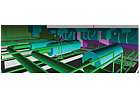
English teachers would disagree, but “Building Information Modeling” is a verb, members of the Mechanical Contractors Association of America were told March 4 during their annual convention in Palm Desert, Calif.
“BIM is a process change, not just a design tool,” said Robert Middlebrooks, industry programs manager for design technology vendor Autodesk.
As a noun, BIM refers to a repository of all information generated, maintained and shared by building team members on a project. The chief advantage of BIM is that it allows a greater degree of collaboration among designers; mechanical, electrical and plumbing contractors; and building owners. Most of BIM’s potential benefits come from members of the construction team sharing the same building model - or different views of the same model, Middlebrooks said.
“We’re all playing in the same sandbox,” he told MCAA members. “I know many of you are frustrated with design professionals; you have trouble getting designs from them. We’ve got to get away from that.
“We’d have fewer problems if we share more information. These are new ways to do that.”
BIM offers contractors and design engineers much more than computer-aided design programs, he said. Among other BIM benefits are the abilities to: create, visualize and document a building design; predict performance, appearance and cost; and deliver the project faster as well as more economically and environmentally feasible.
“BIM is a digital design tool to start with and then provides documentation,” Middlebrooks said. “CAD is the other way around.”
Although new to many contractors, he noted, BIM’s origins can be traced to 2004 when the Construction Users Round Table published a white paper that encouraged collaboration among building team members to increase productivity. Among the goals highlighted were: owner leadership, where building owners become more involved in the construction process; an integrated project structure; open information sharing, where team members trust each other; and virtual building models.
“We want to make the right decisions at the right time,” Middlebrooks said. “We want to move the decision curve earlier when you can do something to contain costs and change the design.”
Contractors need to be involved early in the design process, he said. The sharing of information will be a fundamental of doing business in the future, with BIM acting as a catalyst for Integrated Project Delivery.
“The design process is being redesigned,” Middlebrooks said. “The idea is to bring in all the players early and get them involved in the process.”

